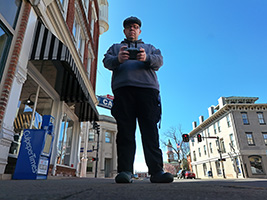ELI5: the American electoral system
7 minute read
August 19, 2013, 12:23 PM
On Reddit, there is a forum (“subreddit”) called “Explain Like I’m Five” (ELI5). It’s not intended for literal five-year-olds, but rather, it’s a venue for people to ask questions, and (hopefully) get a response explaining it all in plain English, with any jargon defined plainly, and complex concepts explained as clearly as possible. Post titles typically begin with “ELI5” with the topic following.
Today on the ELI5 subreddit, this question came up about the American electoral system, as far as presidential elections go:
I’m Australian and having seen a lot about the election last year I couldn’t really find an explanation that I understood about things like swing states, etc.
I feel quite a bit of sympathy for this person. The presidential electoral system in the United States is unique, and let’s admit it: the average American doesn’t even understand how our electoral system works, and many of them have lived with it for their entire lives. For someone who does not live in the United States and is used to a different electoral system, I can imagine that trying to figure out our system can be headache-inducing, to say the least.
So I did my best to explain how it works, including the discussion of how swing states work into it all. The guidelines for this subreddit say that while discussion of politics and controversial topics are allowed, “try to remain textbook-level fair to all sides, for both questions and answers.” I think I did pretty well on that, but I’ll let you decide for yourself. So here’s my (somewhat long-winded) explanation, in plain English:
Basically, here’s how a presidential election in the United States works.
The rules for presidential elections as we know them today were, by and large, set up by the 12th Amendment. The citizenry does not elect the president and vice president directly. Rather, a group of people called “electors” (collectively known as the “electoral college”) vote separately for the president and vice president. These electors have pledged to vote for a certain candidate when it comes time for them to meet and cast their votes. Your vote chooses which electors will be voting. So thus (and this is important), you are not having one big national presidential election, but rather 52 individual elections: one for each state and DC, and then the electoral college’s voting.
Electors are allocated based on the state’s representation in Congress. Therefore, no state can have less than three electoral votes (due to one representative and two senators), and there currently can be no more than 538 total (435 representatives, 100 senators, and three for DC per the 23rd Amendment).
So as I mentioned, on election day, you are voting not for your presidential ticket of choice, but rather for a group of potential electors (equal in number to your state’s congressional delegation) that will cast the electoral votes later. The states determine how their electoral votes are allocated.
In 48 states plus DC, the ticket with the most votes as cast by the citizens of that state get the entire slate of electors. Thus, hypothetically speaking, if there were seven people voting in state X (pretend for purposes of this discussion that this is all the people that showed up in the whole state) that had three electoral votes, and four people voted for candidate Y and three people voted for candidate Z, the entire slate of electors pledged to vote for candidate Y would be the ones who would vote for candidate Y. Candidate Z’s pledged electors are done, and they go home. Candidate Y’s electors will vote for president and vice president (separately) later on.
In Maine and Nebraska, electoral votes are allocated by congressional district, and the electoral votes representing the two senators are allocated by statewide vote. Using Nebraska as an example, there are five congressional districts there. Let’s assume for purposes of this discussion that there are three people in each district. In district 1, 2, and 3, the vote is one vote for Y and two votes for Z. In districts 4 and 5, the vote is two votes for Y and one vote for Z. Thus for the statewide vote, Y got seven votes, and Z got eight. Thus for the electoral vote in Nebraska, Y got two electoral votes, since they won in two districts, and Z got five electoral votes, since they won three districts plus the statewide vote. (Now take this whole paragraph and put it in the back of your head, because despite the different allocation method, it’s rare that they will split their votes, though it has happened before.)
When it comes time for the electoral college to meet, each state’s electors meet and cast separate ballots for president and vice president. Rules on this vary from state to state. In some states, electors are obligated by law to vote for their pledged candidate. In some states, they can technically vote for anyone they want, without legal repercussions, despite which candidate they are pledged to. Likewise, some states have secret ballots for individual electors. Others don’t, and thus electors have to put their name on their electoral votes. (Mind you, in any case, the electors’ names have been made public long before the election, even if they’re not household names. However, if one deviates, the “faithless elector”, as it’s called if someone votes other than how they pledged, may or may not be automatically outed depending on their state’s laws.)
The bottom line is that in 99% of cases, all of the electors chosen by the voters of a state will vote for the same candidate.
Also, it is worth noting that you will most likely not see the names of the electors on the ballot in the voting booth. I have voted in four presidential elections, and only the names of the presidential and vice presidential candidates have ever appeared on the ballot.
This sets us up for the concept of “swing states”. Up until now, I’ve been explaining how it works according to the Constitution and state law. The concept of “swing” states doesn’t factor into that, and is a creation of political pundits and the media. Basically, political pundits can fairly accurately predict how many states’ votes will go based on a number of factors. For instance, most can say with a good amount of confidence that California’s voters will elect a Democratic slate of electors. Thus they are considered a “blue” state (since blue is commonly used to represent the Democratic party). Likewise, we can say with similar confidence that Texas is going to elect a Republican slate. Thus they are considered a “red” state (since red is commonly used to represent the Republican party). So when discussing how they believe that the election will go, pundits can take these “red” and “blue” states as a given in determining how candidates stack up electorally. The states where the pundits can’t confidently make a prediction are the “swing” states. Those are the ones where the outcome is not certain, and the election outcome will most likely be determined by how many of those states a candidate can win “their” electors by the vote of the citizenry. That’s why candidates focus their efforts on these “swing” states: because they can’t say with confidence that they can win in those states, and therefore they have to go out and try to convince people in those states to vote for them (and by “them”, I mean the electors pledged to vote for them in the electoral college). That’s why you usually see candidates showing up a lot in Ohio and Florida, because those states are historically very competitive states, and are often won by very small margins.
That’s also why it all came down to Florida in the 2000 election. Since the final vote tally in Florida, a winner-take-all state, was in dispute, the slate of electors was still undetermined. The constitution requires that a successful candidate receive a majority (currently 270) of the electoral votes, and owing to the closeness of that election, no candidate in 2000 had a majority before Florida’s votes were counted. Additionally, the number of electors in Florida would give each candidate enough electors to reach 270. Once that was settled (a process that I’m deliberately not going to get into) and the electors were determined, the rest of the process could proceed.
But owing to the electoral college, on election night, we still don’t technically have a president, no matter what the media and the candidates might say. Yes, it’s more or less certain who it’s going to be, and the runner-up usually makes their concession speech on election night, but technically speaking, the electoral vote has not yet been cast. That’s done later, and barring any major incidences of faithless electors, it’s going to go exactly as we were told on election night. And then finally, the electoral votes are formally counted on the following January 6 in the House chamber by the President of the Senate (i.e. the sitting vice president). That’s when it truly becomes official, even though the result has been known since early November.
Yes, the presidential election system in the United States is a bit odd. Whether we should keep this system or go to a system of direct election is a subject of perennial discussion, but that’s more or less how it all currently works.
So how did I do? Does this explain how our electoral system works, while adequately covering swing states? I don’t think it’s all that hard, but then again, I majored in public administration in college, and minored in political science. I know this sort of stuff pretty well. But I have had to explain this to a number of folks over the years, since for whatever reason, a lot of people just don’t have a good understanding of how it works.
Looking at my own work, I think I kind of glossed over swing states a little bit despite that swing states were specifically mentioned in the original question, but it’s really just a byproduct of how our patchwork presidential election system functions. I also didn’t discuss the original electoral system, because it was blown away by the 12th Amendment after a very unintended result in 1800 (proof that the Founding Fathers weren’t perfect). I also didn’t discuss what happens when the electoral college is deadlocked, but without the emergence of a major third party, I don’t see the electoral college’s becoming deadlocked again (and thus being decided in the House of Representatives) in our lifetimes.
If you want to add to the conversation on Reddit, feel free to join in the discussion there. Feel free to also leave a comment below for all matters related to this post, or if you are for whatever reason shy about posting to Reddit. And in any case, I hope that this explanation helps you navigate the next presidential election in 2016, as well as elections beyond that.
Categories: National politics, Reddit










Leave a Reply